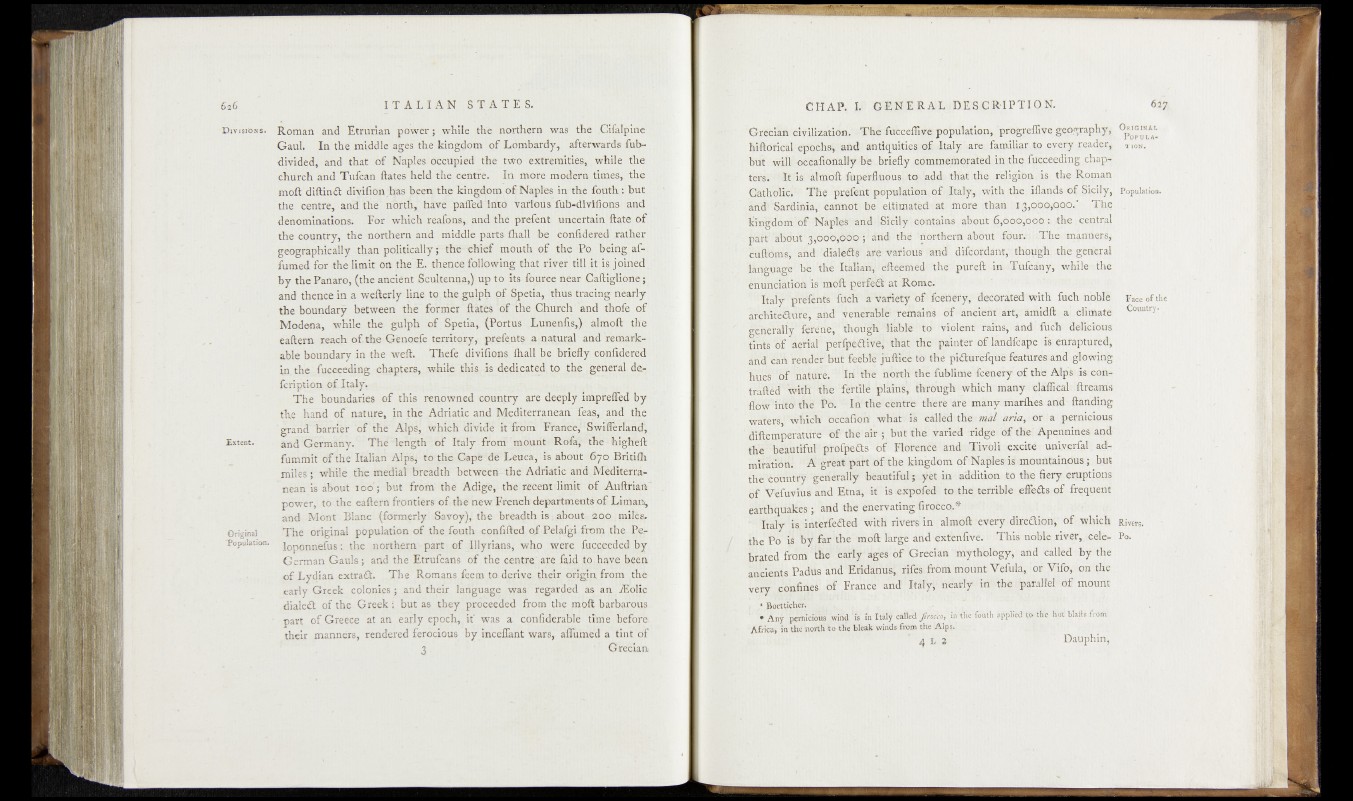
6 û 6
D iv is io n s *
Extent.
Drigfeal ■population.
— ---------------- -------
I T A L IA N STATES .
Roman and Etrurian power;.while the northern was the „Cifalpine
Gaul. In the middle ages the' kingdom of Lombardy, afterwards fub-
divided, and- that of Naples occupied the two extremities, while the
church and Tufcan ftates held the centra. In more modern times, the
moftdiftinfl: divifiondias been the kingdpm of Naples in the fouth: but ‘
the cdnlre, an<f the* north, have'pafled into various fuB-divifions and
denominations. -For which reafons, and the prefent-. uncertain ftate. of \
the country, the northern and middle parts fhall he confidered .rather- ,
geographically than politically j-the -chief mouth of the-?Bo. being af--
fumed for the limit on the K. thence fallowing that river till it is joined,
by the Panaro, (the ancient Scultenna,) up to 3 ts fource near CaftigUphey
and thence in a wefterly line to, the gulph of iSpetia, -thus tracing-nearly
the boundary between the former ftates TiLthe Church ’ and{ithofe df'
Modena, while the gulph of Spetia, (Portus Jblinenfis,.) - almoft the ,
eaftern, reach of.theGenoefe territory, -prefents ,a-natural and remarkable
boundary in the weft. Thefe divifions fhall be briefly cosnfidered
in. the fucceedipg chapters, while this, is dedicated, to the general de-.
fcription of Italy.
The boundaries of this renowned country are deeply, lmpieffed by ‘ ,
the harid of nature, in the Adriatic and Mediterranean Teas*; and the
grand barrier of the Alps, which divide it3?™™ France,* ‘ Swiflerlancf,
and Germany. The 'length | of Italy from jnaurit Rofa, the higheft
fummit rifthe Italian AIp4yto the Capfecfe Leuca*'ds about 670 Britifh
miles; while the medial breadth bbttyeeh'-riie Adriatic and Mediterranean
is about 106'; but from the Adige,- the receht£limit’ bf Auftria»' .
power, to the eaftern frontiers oLthe hew FSeBehdepaftmeflfS'of liiraat^
and Mont - Blanc (formerly Savoy),; the breadth is . about 200 miles.
The original population of the fouth confifted of Pelafgi from the Pe- j
loponnefus: the northern part of Illyrians,- ;'who were fucceeded by
German Gauls ; and the Etrufcans of the centre’ are faid to. have been
of Lydian extraft. The Romans.feem to, derive their origin from the
early Greek colonies; and their language was regarded as an iEolic
dialed of the Greek; but as they proceeded from the moft barbarous.
part of Greece at an early epoch, it' was a conliderable time before-
their manners, rendered ferocious by inceflant wars, aflumed a tint of
3. . ‘ Grecian ,
CHAP.I.^ G®N1 RAL DE;S|G|RIPTI0 N. 6 i j ,
Greciâri/cS$iJizat-ion>.'f"Thei-fiftceffi*^el.population, progreffive geography,
liffiôTic/ahepèÊhsIçand; ^tiqukiesaof Italy Lare^i familiar to every reader^ non.
But will? ofc4alx©^ally 'he* briefly commemorated in^he fqqceedmg^chap-
iers/^ It is^ 'klrfidft fipeuftt|.OUsl;t#7ca^d.. 'thaflthe r.ejj^prij is the Roman
The prnfôntipopulâûon.,oLJjtaly^ {y|th <tlie. iflands of Sicily, Population.
anti^Sardima,' T&g j
ki’nlfddniiof *Nâ^l@âMa,ndîlSÏÈÎlÿ ;üoïîtatiï^, a^api fcdojO^DQ.p;;.jthe yehtnfi
pjfp ’afidut• irid? thë ^norfherh' àb’But tfaur.nu.Thef manners,
.lüftHriis', àfid^dîâleiÉsl a^'vi&ferit^i$<3r difflqMtot,'t thbylgh, -the general
languaf^'M- ftfiè Itkiafiy |ÿftéhmed-,vthe;>.pur'eft fitt^kfcagy, while^the
ènuriëiatrdù is ‘moft- at Rome.
Italy pfefénts'Tceè’^a»variety offc&iery, decôrated'-with fuch noble Face 'of the
afchiteàuj t , "arid! ’ 4eneraf)ife‘ "remains of - arieiërittariy àmidft hi,climate Coantry'
^eralîy^^^,"fïhoug%^Mîle j to’* vf@M#'ïràîhsyàndf TîîSh' delicious
fints oï aerîaP pérfpé&iFéj. that the pa&ntëjrfof la-ntifêafte fis enraptured,
ahd' dâ'À rendëir' but feèble^hflM to the pidtu-rëfquë fktùre's-iand' glowing
M ^Ô f.W ^ ^ -u n '-th e north(th'è fu-blime'-fcenery of thh Mpsui-s. conr- ’
fr'âfteiî'Vith^ë ^eriS^lfesV through Which many'^llffieabiftrearas
flh^hffÿtftë’ » lu' the centre there are mànyomarfhes and - ftandpjg
wafers',i':*hi(Æf bccafidri what is called th e rm a l a ria , • or-* a -pernicious
diftbmpdraufre o f thé* ait ; ( but the varied bridge of the Apennines-and
the'beautiful p'rofpeëts bf Flôre'rïèV andi^Ti^ôliae^citÀ, .uniygrfal ad-
mî^tihtil A' grèatfipart of the -kingdom ef'Naplesri^ -mountainous ; but
the Country genenfllÿ bêautiful ;uÿet in I addition, to t%' fi>rj£ eruption?
6f Véfuvius and Etna, itfisWpofed to the, terrible'.eftèâ;s„of frequent
earthquakes; and the 'enervatingXirofeta*' - ? i f, : $ gty
' Italy i^'interieâed with risers-in'- almoft 'eveiEyidiredlionl' of which Rivers,
the Po li by far the moft large arid exfenisSve. 1 *ThlifmoPk; ,river,,îc.êl,è- Po.
brated frofn’ the early ages o f Grecian’mythology, and called by the
ancients Padüs and Eridanus; rifes from mount Yefula,. ?oi. Vifo, on the
very confines df France and Italy, nearly'in the-parallel dfi mount
. * Boetticher.
* Any pernicious wind is in Italy called f r o t t o , in the fotith applied to the hot4 hlaiis from
Africa, in the north to the bleak winds from the Alps. |
4 1 2 "■ - " Dauphin,
■ ■ ■ ■ ■ ■ W Ê